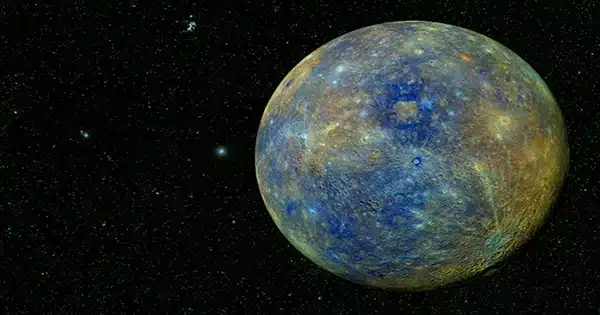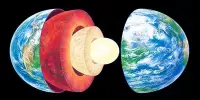A new study maps the infall of protons and electrons from the solar wind to a geographical location on Mercury’s surface, providing scientists with new insights into how interactions with the sun affect the surface and form the planet’s extremely thin atmosphere.
“Studies that have examined the infall of protons and electrons from the solar wind typically map the infall to the surface in terms of time-of-day (dawn, noon, dusk) and not in terms of geographic location (longitude),” said Planetary Science Institute Senior Scientist Elizabeth A. Jensen, a co-author on the paper “Maps of Solar Wind Plasma Precipitation onto Mercury’s Surface: A Geographical Perspective” published in The Planetary Science Journal.
“This is one of the first papers to examine how the surface of Mercury is impacted by charged particles from the solar wind as a function of location on the surface and the energy of the infalling protons and electrons.” This is critical for scientists who study surface qualities.”

“We’re attempting to understand where protons and electrons hit the surface while also accumulating physical effects on the regolith and atmosphere.” Previous graphics illustrate how many protons and electrons impact the surface at different times of the day. But, for example, sunrise occurs everywhere on the planet. So you’d imagine that the number of protons and electrons striking the surface should be the same everywhere.”
“However, Mercury has an extremely unusual orbit and rotation property.” Mercury rotates on its axis three times every two circuits of the sun. This is known as a 3-to-2 spin-orbit resonance. As a result, a Mercury day lasts slightly less than a Mercury year. Furthermore, Mercury spends more time with some longitudes facing the sun than others. “Because the orbit is elliptical rather than circular, the amount of material from the solar wind varies on average depending on where you are in the orbit,” Jensen explained.
“Mapping the infall of these particles must account not only for the spin-orbit resonance and location within the elliptical orbit, but also for the interactions of the solar wind with Mercury’s magnetic field,” Jensen explained. “It’s a complex system with a lot of moving parts.” The modeling results describing the infall of protons and electrons from the solar wind through Mercury’s magnetic field were integrated over the time span equivalent to a full Mercury day, lasting roughly two full orbits of Mercury around the sun, in order to convert the time-of-day maps to geographic maps.”
Deborah Domingue from PSI is also a co-author of the work, which was directed by Federico Lavorenti of the Laboratoire Lagrange of the Observatoire de la Côte d’Azur at the Université Côte d’Azur in Nice, France, and the Dipartimento di Fisica “E. Fermi” at the Università di Pisa in Pisa, Italy. Domingue has investigated interactions between planetary surfaces and the solar wind, whereas Lavorenti is an expert in simulating the interactions of the solar wind with magnetic fields.
“Does this imply that solar winds change the regolith on Mercury’s surface?” Yes, the solar wind does have an effect on the surface. “The interaction of the solar wind, which is a very thin atmosphere, and space weathers the minerals that comprise the surface,” Domingue explained. “This paper does not focus on the formation of the exosphere or the space weathering of the surface, but rather on the variation in radiation flux across the surface that is required for those who study these phenomena.”
Unlike Mercury, Earth’s atmosphere is too dense for solar wind protons and ions to reach the surface. Furthermore, the Earth’s magnetic field only allows infall to occur in the polar regions. This causes the aurora borealis at the north pole, the aurora australis near the south pole, and other phenomena such as polar rain.
















